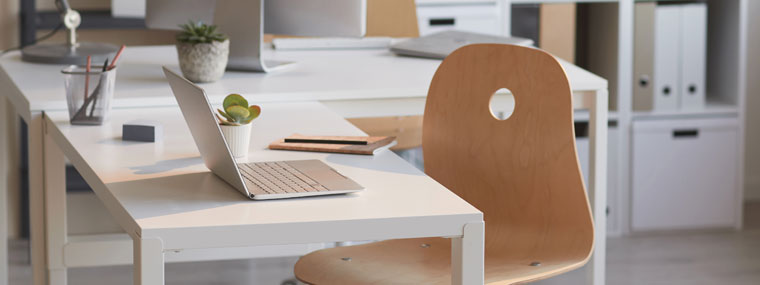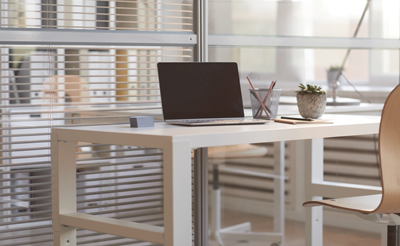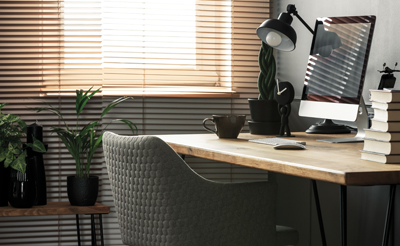
Setting Up Your First Office
By Beth Borrego / Published September 2021

Everyone has to begin somewhere. Many mom-and-pop businesses remain small and home based, but there are also those businesses that grow and expand into brick-and-mortar locations. Not everyone knows how large their business will grow to become or how quickly it will begin to generate business when they are first starting out, but creating a successful work environment designed for the early, high-risk years that are fraught with growing pains is an important step toward success.
The Yankee Candle Company’s founder, Michael Kittredge, was just 16 years old when he began making candles by melting down crayons and adding scent to them in the family’s garage back in 1969. It all began when he made a gift for his mother, and before long friends and neighbors inquired about the candles, requesting to purchase them. Kittredge began to mass produce them in the family garage. Four years later, he outgrew the garage and moved the business to an old mill located in Holyoke, MA.
The Harley-Davidson Motor Company made its first motorbike available to the public in 1903. The factory in which they first worked was a 10 ft. by 15 ft. wooden shed with the words “Harley-Davidson Motor Company” written on the door. Today, Harley-Davidson is perhaps the most sought-after motorcycle brand.
Other well-known brands have had home-based starts as well, including Mattel Toys, Walt Disney, Maglite, Lotus Cars, Hewlett-Packard Company, Google, Apple, and Amazon.com, to name a few. Each of these companies started small and has grown to become globally recognized with popular and trusted brands used by consumers worldwide.
Most blue-collar service professionals do not maintain a store front that is open to the general public unless they are selling inventoried products, or are simply too large to operate without a brick-and-mortar location. This doesn’t mean that your company image will be any less professional because you are small; in fact, your image is extremely important. Without a storefront, the professional image you create for your company will become the face of your business. Having professionally designed and printed business cards, stationery, brochures, and so on is an extremely important part of making a professional impression with a potential client, regardless of where you have hung out your shingle.
 How you set up your first professional office so that you can work both efficiently and effectively is important for several reasons. Most entrepreneurs begin on a very limited budget with limited space and often work very long hours. Pick a space where you can create your office and set it up so that it works well for you. Consider things like the desk, computer, chair, and filing cabinets, which should all be functional.
How you set up your first professional office so that you can work both efficiently and effectively is important for several reasons. Most entrepreneurs begin on a very limited budget with limited space and often work very long hours. Pick a space where you can create your office and set it up so that it works well for you. Consider things like the desk, computer, chair, and filing cabinets, which should all be functional.
Begin with a minimum of furniture. A standard desk with adequate height and an office chair with good lumbar support for your back are important. An L-shaped desk is helpful if you have a PC, but it requires more space. Look through office supply catalogs and online sites to see what’s out there. You may be able to pick the furniture and file cabinets up at a thrift store or an auction.
Make sure the laptop or PC you select is one you will not have to replace for several years, and consider purchasing the extended protection coverage. You’ll need to make some decisions about what software you’ll be using as well. Some of the programs that are popular are Microsoft Office, QuickBooks, and ACT. Office comes bundled with MS Word, MS Excel, MS PowerPoint, MS Access, MS Publisher, and MS Outlook. There is quite a bit of functionality and power in the suite, and it may be that you won’t need all of it, but it is usually the best bang for the buck. QuickBooks has several versions to choose from, and you might want to ask your accountant which one is best for your needs. Many small businesses use QuickBooks Pro. ACT is a contact manager that allows you to record contact information, set up appointments and calls, manage documents, and keep track of your sales pipeline. These and other programs will become an important part of helping you to work as productively as possible. Be sure to back your files up to an external data source like a hard drive or to space on the cloud. Loss of data can be crippling to any business, no matter the size or age.
Store the items you will use frequently within easy reach. Things like files, office supplies, and where the printer and fax are hooked up will all make a difference in how you use your office. Talk to other professionals you know and ask them what has worked well for them and what to avoid.
Get a dedicated business phone. If you have to, you can share that line with your fax machine initially, but be prepared to get a line for your fax later on when your growth supports it. Look into different kinds of phone systems before you make your purchase. Some can be purchased outright and brand new, while others can be leased or rented, even purchased used. It pays to shop around. Just remember, plan that purchase with expansion in mind. One thing to consider is that Microsoft Windows has standard fax software built into it. Buying a PC that has a modem installed simply requires the connection of a cable from the back of the PC to a phone jack, eliminating the need to have one more piece of equipment stacked up in a small home office and allowing you to purchase something else instead, or maybe just something better.
Of course, once you have a dedicated business telephone, you’ll need to treat it like a business phone, too. Answer it professionally, not just with “hello.” While you might think it’s cute to have your child answer your business phone sometimes, the client or potential client on the other end might not feel the same way. It’s better to avoid “little helpers” in the office, cute though they may be. First impressions are important, so answer all calls in a professional manner.
What address are you going to use on all of your listings and on the stationery? Some entrepreneurs use their home address, while others use a post office box if they do not have a brick and mortar location. There are advantages and disadvantages to both. It is nice to receive all of your correspondence at home without having to make a trip to the post office. But, there are people who prefer to keep their home address private and make the trip to the post office box to retrieve their mail. If you live in a single-family home or townhome, a street address at first glance may not catch the sender’s eye, but if you live in an apartment, you might want to get the post office box, since it does look more professional than seeing “Apartment 601” listed after the street address.
When you are looking at printers, remember that a laser printer is a higher quality machine than an ink jet printer is. Pages printed on ink jet printers can smear, especially if they get wet. This could be a big turnoff for a potential customer. Laser jet printers do not do that because the ink fuses to the paper. The laser jet printer is always the more professional choice. Small scanners are also useful, and there are some that allow you to scan documents and to create searchable PDFs.
You’ll also need a decent internet connection so that you can correspond with clients, send and receive documents and attachments, and do any necessary research. Today you can find deals for bundling business telephone options with business internet options. Again, shop around and you might be surprised at what you find out there.
Think about what you would find distracting when you set up where the office will be in the house. Consider things like the kids going loudly in and out of the house, meals cooking in the kitchen, and the sound of the doorbell ringing with unexpected visitors selling anything from lawn service to siding and windows to frozen meats. Can you tune out those distractions? If the answer is no, consider locating your office on a floor other than the main floor of your home. Are you putting the office in a location that will allow you to get up and disconnect yourself from the business so that you can spend time with your family? And, of course, the office is not the place to put your personal toys, like your Xbox or other downtime things. Leave those items outside your office space so that you won’t be tempted to the point of distraction. Keep “gadgets” to a minimum and allow only work-related technology.
Pick a space that doesn’t make you feel claustrophobic and that has adequate lighting. This becomes very important in the winter when the days are shorter. Natural light can help to reduce headaches and eyestrain, allowing you to be more productive, and it is healthier overall.
 It’s also important to remember to get up and walk around and stretch from time to time. Get up, get out, and take a brisk walk even if it’s a short one. Entrepreneurs tend to throw themselves into their work for long periods of time. Take care of your health.
It’s also important to remember to get up and walk around and stretch from time to time. Get up, get out, and take a brisk walk even if it’s a short one. Entrepreneurs tend to throw themselves into their work for long periods of time. Take care of your health.
Are you going to need a shop area to store supplies and equipment? Many a successful business has begun with storage space in a shed or garage, but as you begin to use that space, think about what it is you will need it for, what you can and can’t store, and how to minimize what you do store in order to make the best and most effective use of that space. For example, are there tools that can always be left in your truck? If you do not have storage space of any kind at home to use, consider renting a storage unit, but read the fine print on the agreement because some items, such as chemicals or paints and stains, cannot be placed in storage.
Create a checklist to help you acquire all of the items you need in order to set your office up. Draw a diagram, and plan where everything will go. Get out a measuring tape and take measurements so that when you go out to look at furniture you will know what components will or will not fit without any doubts. It’s far easier to create a brand new space with all of the correct information at your fingertips so that your first office decisions are the best ones for your company.






